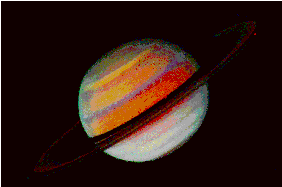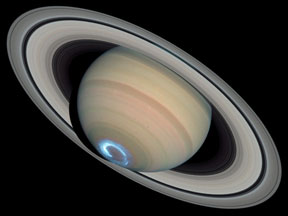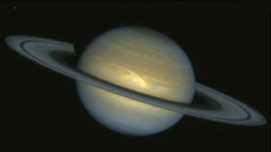This is an image of Saturn in falsecolor. The shadow of Saturn can be seen against the rings in the background.
Click on image for full size
NASA/Hubble Space Telescope
Saturn Clouds, overview
This image of Saturn makes use of false color to show the cloud pattern. The clouds form in bands which move across the disk of Saturn. The banded pattern of clouds, or
stripes, is similar to those found on all the giant planets, particularly in
Jupiter's belts and zones. The similarity among all the giant planets, even
Uranus, suggests that there may be a common way this pattern is created.
Cloud shapes of Saturn include eddy shapes, white ovals, and brown ovals, just like on Jupiter. A row of swirling eddies can be seen in the very middle of this image in white.
There are three clouddecks on Saturn, and each one is composed of different molecules. There is a clouddeck of ammonia clouds, a clouddeck of ammonia hydrosulfide clouds, and a clouddeck of water clouds (H2O).
Hazes of smog on Saturn are to be found at very high altitudes above the clouds of Saturn.
You might also be interested in:

The striped cloud bands on Saturn, like Jupiter, are divided into belts and zones. In a belt, the wind flows very strongly in one direction only. In a zone, the wind flows very strongly in exactly the
...more
The striped cloud bands on Jupiter are certainly not as straight as they appear to be in this picture! The picture shows that the striped pattern is divided into belts and zones. The belts and zones of
...more
The clouds on Uranus, like Jupiter, are divided into belts and zones. On Uranus the belts and zones are hard to find. The left picture shows the north pole of Uranus. In this picture only the smog of
...more
The dramatic appearance of Saturn stems mainly from the spectacular rings. The atmosphere looks much less dramatic. The clouds of Saturn are much less colorful than those of Jupiter. This is because the
...more
Have you ever seen the Southern or Northern Lights? Earth isn't the only planet that puts on these beautiful light shows, which are also called the "aurora". Aurora have been seen at both poles of Saturn,
...more
Astronomers have discovered a strange shape in Saturn's atmosphere. The shape is a hexagon. The hexagon is near Saturn's North Pole. Scientists aren't quite sure why Saturn has the hexagon shape in its
...more
The most important motions in the atmosphere are winds. The major winds in Saturn's atmosphere are the zonal winds which are made of zones and belts. Zones are high pressure systems and belts are low pressure
...more















